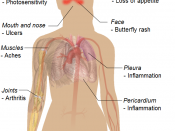Lupus
Mugs Blank
Anatomy/Physiology
Period 4
January 9, 2002
Lupus, is a chronic, autoimmune disease, which causes inflammation of various parts of the body, especially the skin, joints, and kidneys. The body's immune system normally makes proteins called antibodies to protect the body against viruses, bacteria and other foreign materials. These foreign materials are called antigens. In an autoimmune disorder such as lupus, the immune system loses its ability to tell the difference between foreign substances (antigens) and its own cells and tissues. The immune system the make antibodies directed against "self". These antibodies, called "auto-antibodies," react with the "self" antigens to form immune complexes. The immune complexes build up in the tissues and can cause inflammation, injury to tissues, and pain.
There are currently three types of lupus; Discoid lupus, Systemic lupus erythematosus (SLE), and a lupus-like syndrome (called drug-induced lupus). Discoid lupus is limited to the skin and is identified by a rash that may appear on the face, neck, or scalp. The rash may be more apparent on areas of the skin exposed to ultraviolet light. Although there are many types of lupus rash, the most common is raised, scaly and red, but not itchy.
Systemic lupus erythematosus (SLE) is usually more severe than discoid lupus. This type of lupus can cause inflammation in a number of organs. For some people this may be limited to skin and joint involvement. In others, the joints, lungs, kidneys, blood or other organs and/or tissues may be affected. SLE may include periods in which few, if any, symptoms are evident and other times in which the disease becomes active.
Certain prescribed drugs can create a lupus-like syndrome (called drug-induced lupus) which is similar to SLE. This type of lupus very rarely affects either the kidneys or the nervous...



Lupus
relate this to the social and political views of disability and the stereotypes surrounding the persons with this diagnosis and further discuss the developments and th laws affecting this particular disability
3 out of 3 people found this comment useful.